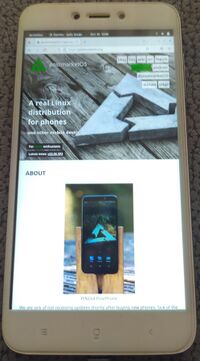Xiaomi Redmi 5A (xiaomi-riva)
Appearance
| This device is supported as part of a generic port. Refer to Generic MSM89x7 (qcom-msm89x7) for installation instructions and more information. |
 Redmi 5A running gnome-mobile | |
| Manufacturer | Xiaomi |
|---|---|
| Name | Redmi 5A |
| Codename | xiaomi-riva |
| Released | 2017 |
| Type | handset |
| Hardware | |
| Chipset | Qualcomm Snapdragon 425 (MSM8917) |
| CPU | Quad-core 1.4 GHz Cortex-A53 |
| GPU | Adreno 308 |
| Display | 720x1280 IPS |
| Storage | 16/32 GB |
| Memory | 2/3 GB |
| Architecture | aarch64 |
| Software | |
Original software The software and version the device was shipped with. |
Android 7.1.2 (MIUI 9) |
Extended version The most recent supported version from the manufacturer. |
Android |
| postmarketOS | |
| Category | testing |
Mainline Instead of a Linux kernel fork, it is possible to run (Close to) Mainline. |
yes |
pmOS kernel The kernel version that runs on the device's port. |
6.13 |
| Generic port | Generic MSM89x7 (qcom-msm89x7) |
| Device package |
|
| Kernel package |
|
Flashing Whether it is possible to flash the device with pmbootstrap flasher. |
Works
|
|---|---|
USB Networking After connecting the device with USB to your PC, you can connect to it via telnet (initramfs) or SSH (booted system). |
Works
|
Internal storage eMMC, SD cards, UFS... |
Works
|
SD card Also includes other external storage cards. |
Works
|
Battery Whether charging and battery level reporting work. |
Works
|
Screen Whether the display works; ideally with sleep mode and brightness control. |
Works
|
Touchscreen |
Works
|
| Multimedia | |
3D Acceleration |
Works
|
Audio Audio playback, microphone, headset and buttons. |
Works
|
Camera |
Broken
|
| Connectivity | |
WiFi |
Works
|
Bluetooth |
Works
|
GPS |
Works
|
| Modem | |
Calls |
Partial
|
SMS |
Works
|
Mobile data |
Works
|
| Miscellaneous | |
FDE Full disk encryption and unlocking with unl0kr. |
Works
|
USB OTG USB On-The-Go or USB-C Role switching. |
Broken
|
| Sensors | |
Accelerometer Handles automatic screen rotation in many interfaces. |
Works
|
| This device is based on the Snapdragon 425. See the SoC page for common tips, guides and troubleshooting steps |
Contributors
Maintainer(s)
Users owning this device
- AppData 174
- Bczeman
- CoderCharmander (Notes: Recently superseded by my new phone, trying to port various Linux distros on it)
- Ellychnium
- Gelzar2041 (Notes: slightly cracked screen, 2/16)
- Hander (Notes: testing rolex version on riva)
- Meowka (Notes: Boots with kernel for android)
- Misopog (Notes: Few scratches, stock)
- Paricbat (Notes: Im not sure if it works, cracked screen)
- Veynamer (Notes: broken touch(fixed))
How to enter flash mode
- Shutdown the phone completely
- Hold and until fastboot logo
Installation
- Follow the Installation guide
| Warning: Flashing lk2nd is required, as it is a hard dependency. Without it the mainline kernel will not select the display panel (resulting in black screen on boot). |
$ pmbootstrap init # choose Vendor: qcom Device codename: msm89x7
$ pmbootstrap install
$ pmbootstrap flasher flash_lk2nd
$ pmbootstrap flasher flash_rootfs
Wifi
To connect to a wifi network simply run:
$ sudo nmtui
And connect to your prefered wifi network using the terminal UI.
Note: Use the wlan0 interface.
Notes
- Some desktop environment will result in a blank. LXQT or SXMO UI is Recommended to use.
- KDE Mobile DE may be struggling running on this device
See also
- pmaports!3595 Initial merge request
- Specs on GSMArena.com